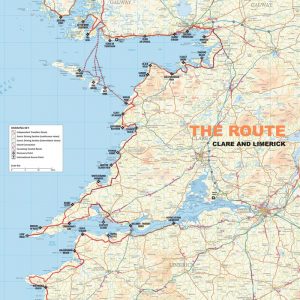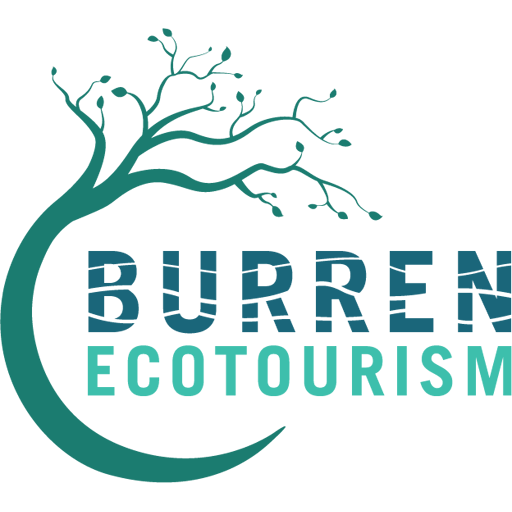 The Wild Atlantic Way is a coastal route spanning seven of Ireland’s counties.
The Wild Atlantic Way is a coastal route spanning seven of Ireland’s counties.
159 Discovery Points along the way highlight distinct areas each chosen for their potential to offer an authentic and intimate experience of the natural and wild landscape and seascape. 15 of these Discovery Points have been identified as “Signature Discovery Points” – in other words, iconic must-see sights along Ireland’s west coast. There are 26 offshore west coast islands which are all Discovery Points,  ‘Embarkation Points’ on the route provide direction and access to these islands.
‘Embarkation Points’ on the route provide direction and access to these islands.
Wild Atlantic Way Discovery Points in County Clare
Flaggy Shore
The Flaggy Shore is 0ne of the most northerly parts of County stretching from the village of New Quay to Finvarra Point. Flaggy Shore is a Geosite, one of nine sites of geological importance that form the basis of the Burren and Cliffs of Moher Geopark. Famous for its limestone pavements, fossils embedded in the rock, including sculptured rocks along the shore called ‘Biokarst’. A paved road runs along the shore making it ideal for walkers of all ability and age.
Ballyvaughan Pier
Ballyvaughan is small harbour village in County Clare located off the N67 along the southern shores of Galway Bay. The harbour is defined by a 50m long pier and a working quay used by the boats that ply the bay. Both locations are favourite places for anglers. Ballyvaughan Village hosts a Saturday Farmers Market and a Sunday Craft Fair from April to September. Look out for Ballyvaughan Heritage Trail which starts at Ballyvaughan Pier.
Blackhead
Black Head Discovery Point is characterised by the ‘lunar’ landscape of the Burren comprising smooth rocks and bordered sheer gullies known as ‘grykes’. Abundant flora grows within these grykes some distinctive to the Burren such as the maiden fern. Car Parking spaces are limited at the informal layby. The 26km Black Head Loop Walk begins at Fanore Beach and follows the coast around Black Head via Green Road in addition to the neighbouring Gleninagh Pass, Cappanawalla, Feenagh Valley and Ballelly.
Fanore Beach
Fanore Beach is one of nine sites of geological importance that form the basis of the Burren and Cliffs of Moher Global Geopark. Fanore has a large sandy beach and extensive sand dune system. It is very popular with walkers, swimmers and surfers. The beach is located in close proximity to Fanore village which includes a coffee shop, pub, shop and campsite . The caravan park is located within the adjacent dunes and there is car-parking and an access road off the R477 to the beach.
From Fanore beach the Burren is in easy walking distance.
Doolin Pier/Port
Doolin Port is set against the rugged Atlantic Ocean and surrounded by the spectacular bare limestone landscape of the Burren. This discovery and embarkation point is in close proximity to Doolin village, a popular tourist destination that is renowned for its traditional Irish music. Doolin Pier is one of nine sites of geological importance that form the basis of the Burren and Cliffs of Moher Geopark.
Cliffs of Moher
The Cliffs of Moher is one of nine sites of geological importance and is part of the Burren and Cliffs of Moher Geopark region. The Cliffs of Moher are one of Ireland’s most visited natural attractions. The Cliffs of Moher and Visitor Centre are open all year round. Highlights include over 800m of cliff edge paths and viewing areas, the gothic style 19th century O’Briens Tower near the highest point of the cliffs and the eco-friendly underground visitor centre building containing visitor services and facilities, gift shop, restaurant & coffee shop and the award winning Atlantic Edge Exhibition.
As a special protected area (SPA) for seabirds the Cliffs are home to over 30,000 pairs of seabirds. Internationally significant numbers of both Guillemots and Razorbill can be found here along with Puffins, Kittiwakes, Fulmars, Peregrine Falcons and Choughs.
Lahinch/Lehinch Beach
Lahinch Beach, widely considered one of Ireland’s finest beaches, is a hot spot for surfing and kitesurfing. The beach stretches for approximately 1.6 km with spectacular views. Lahinch Seaworld & Leisure Centre, located on the promenade, has a state of the art Gym and Pool and cater for all ages running Birthday Parties, Group Parties, Beach Tours and much much more. Next door you will find Lahinch Adventures who offer surfing lessons and other activities. The beach at the village of Lahinch is located on the N67 road along the eastern shores of Liscannor Bay.
The Aran Islands
Inisheer (Inis Oírr)
This island lies 8 kilometres off the coast. Inisheer has probably been inhabited for 5,000 years but the earliest evidence of civilisation is at Cnoc Raithní, a Bronze Age burial mound dating from 1500BC. Nearby are Teampall Chaomhán, a Medieval church ruin and the 16th Century Caisleán Uí Bhríain, a three storey tower house built within a Stone Age fort. To the north of the island are vistas of Connemara, the eastern shore has views of the Cliffs of Moher and the Burren.
Inishmaan (Inis Meain)
Located in the middle, it is around three miles long by a mile wide and is said to be the most unchanged of the Aran Islands. It has an exceptional range of flora, including orchids, gentian, sea thrift, honeysuckle, harebells, burnet rose, bloody cranesbill and many more. Being the quietest of the Aran Islands it a great place to escape the crowds and enjoy its nature.
Inishmore (Árainn Mhor)
The largest of the Aran Islands attracting visitors to its rugged shores for generations. The island is an extension of the the Burren landscape, where limestone pavements crisscrossed with grikes, host a variety of wild flowers. The landscape of Inishmore is a patchwork of fields hemmed in by ancient dry stone walls.
Wild Atlantic Way useful links
Irelands Wild Atlantic Way – Twitter
Wild Atlantic Way – Facebook
Wild Atlantic Way – Blog
Wild Atlantic Way – Discover Ireland page
Wild Atlantic Way Video available on You Tube
Wild Atlantic Way Guidelines and request for the Wild Atlantic Way logo
